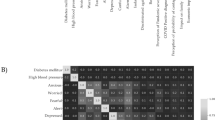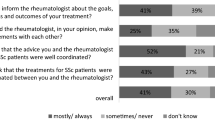Abstract
This study aims to explore the different connotations and potential offensiveness of ten mechanistic labels in newly referred Mexican patients with rheumatic symptoms as well as in Mexican and Canadian rheumatologists. Patients with musculoskeletal complaints newly referred for a rheumatology assessment were interviewed consecutively before they saw the rheumatologist. Patients were asked to choose one of nine feelings provoked by ten different illness mechanism labels. Rheumatologists gave a medical diagnosis after seeing the patients. Mexican and Canadian rheumatologists were invited to answer a structured questionnaire about their feelings at the moment they identified each of the ten different provided scenarios. Patients' and rheumatologists' feelings were classified as “offended” or “nonoffended.” The “offensive score” was used to calculate a “number needed to offend” (NNO). One hundred and fifty patients were included. Inherited, immunological, and inflammatory labels had the fewest negative connotations (NNOs 17, 12, and 14, respectively), and psychological, functional, idiopathic, and sleep disturbance labels had the most (NNO 2 and 3, respectively). Functional labels were almost four times more offensive than organic labels. Stratified by rheumatologist diagnosis, patients with functional disorders were more accepting of organic-based mechanistic labels. A higher potential to offend was observed when patients with functional somatic conditions were given functional mechanistic labels (NNOs 1 to 4). The survey was completed by 186 Mexican rheumatologists and 71 Canadian rheumatologists. Primarily functional disorders such as somatization and anxiety had a high potential to evoke offensive feelings (NNOs 3 to 7). No significant differences in the NNO were found between Mexican and Canadian rheumatologists. Getting or giving mechanistic/explanatory labels is emotional. Both patients and rheumatologists experienced offended feelings with functional or idiopathic labels.
Similar content being viewed by others
References
Maiden NL, Hurst NP, Lochhead A, Carson AJ, Sharpe M (2003) Medically unexplained symptoms in patients referred to a specialist rheumatology service: prevalence and associations. Rheumatology (Oxford) 42(1):108–112
Nimnuan C, Hotopf M, Wessely S (2001) Medically unexplained symptoms: an epidemiological study in seven specialities. J Psychosom Res 51(1):361–367
Laine C, Davidoff F (1996) Patient-centered medicine. A professional evolution. JAMA 275(2):152–156
Ramos-Remus C, Salcedo-Rocha AL, Prieto-Parra RE, Galvan-Villegas F (2000) How important is patient education? Baillieres Best Pract Res Clin Rheumatol 14(4):689–703. doi:10.1053/berh.2000.0107
Bardes CL (2012) Defining “patient-centered medicine”. N Engl J Med 366(9):782–783. doi:10.1056/NEJMp1200070
Boyle D, Dwinnell B, Platt F (2005) Invite, listen, and summarize: a patient-centered communication technique. Acad Med 80(1):29–32
Donovan JL, Blake DR, Fleming WG (1989) The patient is not a blank sheet: lay beliefs and their relevance to patient education. Br J Rheumatol 28(1):58–61
Aceves-Avila FJ, Ferrari R, Ramos-Remus C (2004) New insights into culture driven disorders. Best Pract Res Clin Rheumatol 18(2):155–171. doi:10.1016/j.berh.2004.02.004
Beckman HB, Markakis KM, Suchman AL, Frankel RM (1994) The doctor–patient relationship and malpractice. Lessons from plaintiff depositions. Arch Intern Med 154(12):1365–1370
Stone J, Wojcik W, Durrance D, Carson A, Lewis S, MacKenzie L, Warlow CP, Sharpe M (2002) What should we say to patients with symptoms unexplained by disease? The “number needed to offend”. BMJ 325(7378):1449–1450
Cook RJ, Sackett DL (1995) The number needed to treat: a clinically useful measure of treatment effect. BMJ 310(6977):452–454
Walker EA, Katon WJ, Keegan D, Gardner G, Sullivan M (1997) Predictors of physician frustration in the care of patients with rheumatological complaints. Gen Hosp Psychiatry 19(5):315–323
Duch L (2002) Antropología de la vida cotidiana: Simbolismo y salud. Editorial Trotta, Madrid
Avenel NJ (1989) Webster's encyclopedic unabridged dictionary of the English language. Gramercy Books, p. 1000
Miller WI (1998) Anatomía del asco. Taurus, Madrid
Kleinman A (1997) What is specific to biomedicine? Writing at the margin: discourse between anthropology and medicine. University of California Press, Berkeley
Evans M (2001) The “medical body” as philosophy's arena. Theor Med 22:16
Chauvenet A (1989) Biología y gestión de los cuerpos. In: Achard PCA, Lage E, Lentin F, Néve P, Vignaux G (eds) Discurso biológico y orden social. Crítica de las teorías biologicistas en medicina, psicología y ciencias sociales, 2nd edn. Nueva Imagen, México
Lillrank A (2003) Back pain and the resolution of diagnostic uncertainty in illness narratives. Soc Sci Med 57(6):1045–1054
Finset A (2012) “I am worried, doctor!” Emotions in the doctor–patient relationship. Patient Educ Couns 88(3):359–363. doi:10.1016/j.pec.2012.06.022
Album D, Westin S (2008) Do diseases have a prestige hierarchy? A survey among physicians and medical students. Soc Sci Med 66(1):182–188. doi:10.1016/j.socscimed.2007.07.003
Campbell EJ, Scadding JG, Roberts RS (1979) The concept of disease. Br Med J 2(6193):757–762
Meador CK (1965) The art and science of nondisease. N Engl J Med 272:92–95. doi:10.1056/NEJM196501142720208
Disclosures
None.
Author information
Authors and Affiliations
Corresponding author
Rights and permissions
About this article
Cite this article
Castillo-Ortiz, J.D., Russell, A.S., Davis, P. et al. The number needed to offend: a cross-sectional study of potential offensiveness of rheumatic diagnostic labels. Clin Rheumatol 33, 561–566 (2014). https://doi.org/10.1007/s10067-013-2407-z
Received:
Accepted:
Published:
Issue Date:
DOI: https://doi.org/10.1007/s10067-013-2407-z




